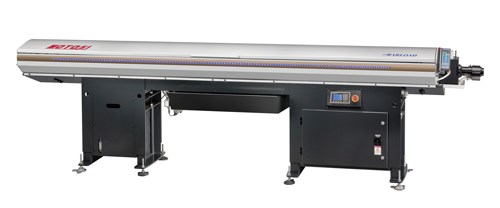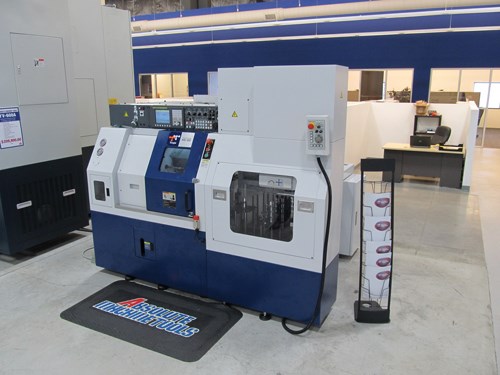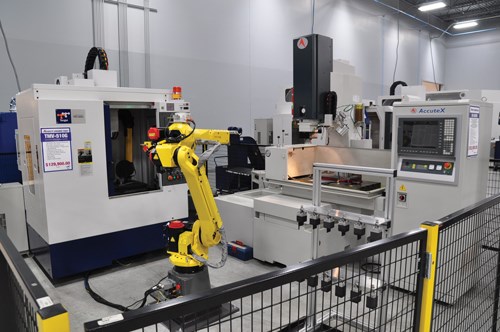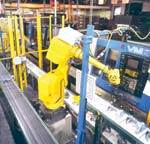Technology Advances Automation Trends
Shops of all sizes looking for better efficiency are realizing the benefits of a deeper investment into automation.
Varying degrees of automation provide a range of options to match what a shop needs with what it can afford. For those involved in turning, three levels of automation are available to bring material to the machine tool. But higher production demands and advancing technology have made higher-end automation commonplace, even in small shops.
Bar Feeders
Bar feeding, with which all turning shops are familiar, has been used for a long time. The 12-ft. magazine bar feeder can often provide the capacity to process parts for an entire shift. It offers fast cycle times, efficient bar utilization, low labor cost (one operator can load several machines), and the ability to run unattended for long intervals. For this form of automation to run successfully, though, an assortment of process variables must be under control. The bar feeder must be engineered to stabilize a large amount of mass spinning at high rotational speeds. It must also be built to absorb the vibration and harmonics associated with a rotating bar subjected to accelerating and decelerating speed levels during the machining process.
Due to the high spindle speeds of today’s machine tools, vibration can create issues during the turning operation. But just as the machine tools have become more stable through time, so have bar feeders, with a stronger base and minimal deflection to help dampen imperfectly balanced barstock.
Bar feeders remain the most efficient way to supply materials to turning machines in the production of small parts and, therefore, are unlikely to be eliminated. But larger parts can severely limit the capacity of the bar feeder for extended runs without operator intervention, and chucked components require an entirely different form of delivery. In these cases, automation can look much different.
Canned Automation
What many might consider a step up from bar feeders involves automated parts loading and unloading, often offered by a machine tool builder or manufacturer of machine tool accessories. These stand-alone units, once stocked, feed the machine tool as well as remove completed parts into a rack or chute for manual sorting later. The self-contained and pre-guarded part loaders/unloaders can offer as much as 50-percent faster loading times than manual loading, enable lathes to operate without operator attention for long periods of time, and combine more consistent production with more accurate scheduling.
These systems may be designed for specific machine series or are often retrofitted to non-specific models as needed. They are commonly custom designed to accommodate individual part sizes and shapes, orientation, the need to invert the part, the need to protect the part, and even the length of time the customer wants to be able to run the lathe unattended. They can be integrated into the full functionality of the machine or be floor mounted in front of the machine where the operator would normally stand, with provisions for easily swinging it away from the machine to provide access for setup changes or to accommodate short-run, manually-fed jobs.
While relatively limited in their capabilities for part movement, they can provide a nice price break from robotic systems. Parts loaders are delivered ready to go, in contrast with robots, whose ancillary equipment, such as guarding, fixturing, end-of-arm tooling, and systems for moving the finished parts away, can end up doubling or even tripling the overall cost.
Robotics
The highest level of automation is a full robotic cell. The robot can pick up parts (with vision systems often allowing them to be in any orientation) and place them into a chucker or machining center. Not long ago, robots were rarely seen in job shops or small to medium sized companies. This more expensive technology was generally seen as too complex and, thus, reserved for large plants such as Tier 1 automotive. But in recent years, we’ve seen a trickle-down as shops attempt to meet the push to get more done with less. While shops have been facing the constant challenge of finding enough qualified people, the market for robots has steadily increased.
Although totally unattended operation in an unmanned shift is difficult to pull off, even lightly tended operation, which this shortage of personnel often demands, can be greatly assisted by automated robotic loading. And as robotic capabilities advance further, cost justification becomes easier. Although the robot must have some operator assistance for supplying materials, it can provide short ROI by providing reliable operation 24 hours a day, 7 days a week—no breaks and no paid benefits.
Implementation
Bringing robotics into a shop does not need to be a difficult process. Last year, Absolute Machine Tools achieved Authorized Integrator status with Fanuc Robotics America Inc. As such, the company can combine its machine tool product offering and engineering experience to provide turnkey, production-specific machining systems. Integrators such as Absolute work closely with customers to determine the appropriate automation systems for the application, set up operational cells, and train operators.
Steve Ortner, president of Absolute, explains some of the challenges that an integrator can help to address when implementing robotic automation. “One of the most significant issues we deal with is determining the most efficient way to get the parts to the robot. The robot is attached to the floor, so its reach is limited. How involved will shop personnel be in part delivery and how extensive will conveyor systems be? We help to lay out the entire part handling process.” Once the part is presented to the robot, orientation may be significant. “Vision systems have gotten very sophisticated, and they have helped to make the material handling process much more efficient,” Mr. Ortner says. “The robot can simply look at a part and adjust to its orientation.”
Post Process
An automated setup will typically have gaging built into it—checking a result and adjusting for it automatically. This type of system is not new. But as smaller shops get more sophisticated with their automation processes, this post process technology advances as well. “Robots are working their way down into places that 5 or 10 years ago they wouldn’t have even been considered,” Mr. Ortner says. “They’re not only handling part movement in and out of the machine, but they’re performing post process duties, as well. We have three quotes out right now for robots to do deburring and polishing, and even some grinding.”
The robot can act as a person with a hand grinder. Parts come off of a machine, and they still often require manual polishing or some other basic finishing operation. These operations can be labor-intensive and maybe somewhat dangerous. The robot can grab the piece, and with force sensing on the end-of-arm tooling, it knows how hard it is grinding—how much pressure is being applied to the wrist. “It’s similar to a person having a feel for the operation,” Mr. Ortner says. “Is he pushing too hard or too little? The robot can sense this as well and adjusts automatically and compensates for what is required.”
With enough planning and the right technology in place, so much more of the process can be automated than before. Many of the inconsistencies of manual work can be eliminated as the robots produce the same results every time. And an added benefit is the reduction of workplace injuries.
Changing Course
Not too long ago, machine tool suppliers commonly would sell a machine, drop it off on the shop floor, bolt it down, turn it on and be on their way. But over time, the relationship between vendor and buyer has become much more of a partnership, and both benefit from the success of each other. Suppliers are being asked to do far more of the manufacturing engineering for the shops. Mr. Ortner explains, “The trend does seem to be for shops to lean more on the expertise of their suppliers. As an example, you’ll always have a need for standard machines—simple two-axis lathes and three-axis mills. But for big parts, companies are starting to go more for double-column machining centers with an attachment changer for multiple heads and the ability to work all five sides of the part. We’ve sold more of that type of machine in the last 12 months than all other years combined.”
The reason shops are going this direction seems to be that they don’t have the people who can move the part from one machine to another and handle multiple setups. Instead, they need to find ways to get things done with minimal handling and manual intervention. The trend has always been in that direction, but it continues to accelerate as more people buy into the philosophy and prices continue to come down. This trend applies across the board for automation. Robotics is no different.
“Robots are getting better and better at mimicking what a person can do,” Mr. Ortner says. “They’ve always been able to pick things up and move them from one place to another. But now they can see and feel, so they have far more functionality.” Because this functionality is being paired with prices that are more in reach of smaller shops, the trend will continue to advance.
Related Content
Bar Feeder for Sliding Headstock Lathes Enables Higher RPMs
PMTS 2023: The LNS GT 342 automatic magazine bar feeder is designed to enable fast and easy diameter changeovers and improved productivity.
Read MoreBar Feeder Offers Simple, Fast, Silent Automation
PMTS 2023: Bucci Industries’ Next 25 bar feeder offers high rotational speeds (more than 10,000 rpm) and fast, unattended bar changes with high indexing and silent performance.
Read MoreRead Next
Is Robotic Automation Becoming Practical For Low-Volume Production?
High-volume manufacturing and robotic automation go hand in hand. Machine-tending robots used in these production schemes need not be very flexible, as they may just load and unload one type of part hundreds of thousands of times.
Read MoreA Tooling Workshop Worth a Visit
Marubeni Citizen-Cincom’s tooling and accessory workshop offers a chance to learn more about ancillary devices that can boost machining efficiency and capability.
Read More5 Aspects of PMTS I Appreciate
The three-day edition of the 2025 Precision Machining Technology Show kicks off at the start of April. I’ll be there, and here are some reasons why.
Read More.png;maxWidth=970;quality=90)












.png;maxWidth=300;quality=90)











